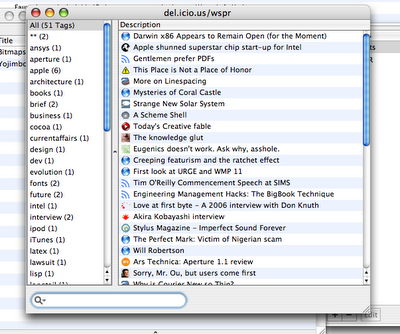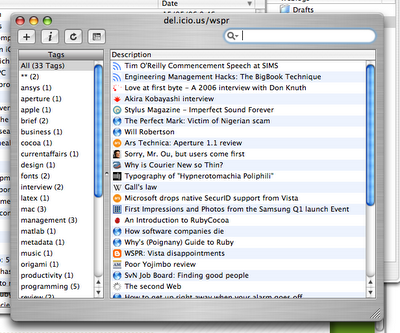After renouncing the use of my PowerBook at work for efficiency reasons, I’m now in the tricky situation of having to synchronise stuff back and forth between my Mac at home and my Windows box at uni.
Generally, this isn’t a problem. I really liked being able to rsync my files back and forth when I was using Linux, which meant that I could do my writing on my PowerBook and my work on the desktop. But really, I can probably deal with using TeX on Windows; the only thing I’ll miss is BibDesk, I think.
(By the way, my switch back to Windows from Linux was due to the fact that engineering software — Matlab, specifically — just works so much better under Windows and I was sick of having to deal with Linux’s idiosyncracies. At least I know what I’ve got under Windows; even if that is an inelegant mess, it at least works for the things I need it for.)
Perhaps the biggest concern I had was a calendar platform I could use both at uni and at home, as well as allowing iSync to sync everything up with my phone. And I’ve decided it’s too hard to be worth doing. Which is a little sad, but now that I think of it, it’s not the worst thing in the world to use my phone when I’m away from my PowerBook at home.
But while trying to fix this problem, I very briefly came into contact with a whole bunch of online Web 2.0 calendar apps. A totally unrepresentative list of possible choices:
Most of these were obtained from the comprehensive TechCrunch.
I used none of them long enough to be able to actually review them in any decent capacity. But that won’t stop me from passing judgement. Each does more-or-less the same thing. It’s possible to export your data in various ways, in iCal or RSS formats, amongst others — including being able to embed mini calendars within your own web pages. It’s interesting to see the different spins each company takes, with some more successful than others at creating an experience that's interesting to use.
Of those mentioned above, I’d rank them in the order given. The first two have great, and simple, interfaces. The experience is all quite nice, and if I was the kind of person who liked web apps, I’d have no problem recommending them. (Uploading my phone calendar, however, is still a problem.) The most innovative element of both of them is free-form entry input. No more clumsy clicking. Just nice typing, e.g., “party 10pm friday at justin’s” in a text field.
The big guns, the Yahoo and Google calendars, offer exactly what you’d expect. The sort of “no design” that people like to discuss at the moment, and integration with their other services that lowers the cost of entry.
From there, Planzo and CalendarHub were respectively clumsy and broken. They just don’t have the “sparkle” to make them attractive, from more complex sign-up schemes in the former (including HTML email) to simply broken functionality in the latter (beta, I don’t care — if they’re public, they should work). The interfaces to both were cluttered and not pleasant to nest in.
But the real lesson I learned was that web apps are really at the cutting edge of interface design. I suspect this is due to the startup culture allowing designers to work really closely with the final product, in combination with the fact that the line between web app developer and designer are blurred so much that the developers actually have a clue about decent design.
It’s just a pity that the calendar in my phone has no way of getting inside one of these nice online ones. Or if there is, it’s just too hard at the moment.
Postscript: another option I looked at was using iCalX to share webdav calendars between SunBird and iCal, which has the potential for working nicely but which never quite clicked. Actually, I’m not sure why this didn’t solve all my problems so I might have to revisit it again soon.




